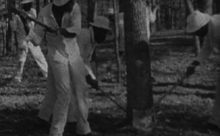Pete and Toshi on Making the Film
PETE SEEGER: We made Afro-American Work Songs in a Texas Prison thanks to Bruce Jackson, who had been tape recording stories of the prisoners, and I guess some songs, too, but mainly stories, and who had also stayed on good terms with the warden of the prison at Huntsville and with some of the guards. They got to know each other. A liberal had gotten appointed in charge of the Texas prison system and persuaded the taxpayers that they were wasting a lot of money by not giving these prisoners machines to work with. If you mistreat a prisoner, they’re going to mistreat the machine. But he said, “Treat them decently and they’ll treat their machines decently.” So Bruce said, “Pretty soon nobody will know the old work songs. They’re using tractors now.” So he got permission for us to take a camera down and film the work songs with the last crew that knew how to sing the old songs.
TOSHI SEEGER: Most people, if they are filming have a storyboard or script or something. They know what is happening. I had no idea at any time. The boatsingers film footage we made in Ghana [1964], I saw that happening and I said, “let’s stop and get that.” But in the Texas prison I had no idea what was going to happen. We set up the cameras and began filming. At the point that we set the cameras up I saw that they were going to do work songs, so any of the framing is on the spur of the moment, done just as we saw it.
PETE: And at the end of the day of filming, the guard, who was on a horse and who was often talking to a friend, wasn’t even watching us…
TOSHI: Well you were talking to him and I was with all the prisoners with double-edged axes. I thought it was very humorous. I shot the film, with the guard on the horse looking away paying no attention to me. These men were telling me their life stories—why they were in there, about their children and wives, and so forth…
PETE: And at the end of the day the guard says, “Come on men, Hollywood’s over.”
